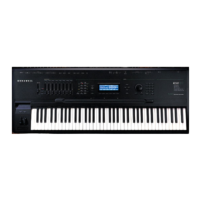Multi Edit Mode
Arpeggiator, CC Seq and Riff Page
5-19
Local
When Local is set to O, notes will only be played by the ri. When Local is set to On,
notes in the current zone can be played normally by the keyboard, and by the ri.
Loop
When Loop is set to O, the ri will play once until it is retriggered. When Loop is set to
On, the ri will play in a loop until a key in the Release Range is released.
Riff Tempo
Use the Ri Tempo parameter to set the tempo of your ri. With Ri Tempo set to Song,
the ris original tempo from song mode will be used. With Ri Tempo set to Multi, the
tempo set on the Multi Edit Common page will be used. e Multi setting is useful for
tempo syncing dierent ris or arpeggiators. With Ri Tempo set to External, the ri will
sync to external MIDI clock. You can also manually choose a tempo by selecting a value from
20 to 400.
Trigger Master
e Trigger Master parameter determines which zone a ri will sync to when triggered. is
allows you to trigger ris in sync with other ris or arpeggios by syncing to the beat of ris or
arpeggios in other zones.
For example, if you have a drum ri in zone 1 and a bass ri in zone 2, you may always want
the bass ri in zone 2 to sync to the drum ri in zone 1. In this case you would set the bass
ri Trigger Master to Ri Zone 1.
You may want to have a little more freedom and not be tied to the drum ri as the main
“timekeeper.” Maybe you want to start with the bass ri and have the drum ri start later. In
this case you would set Trigger Master to First Ri. With this setting, the ri will look for
the rst available ri to sync to. So if both the drum ri and the bass ri have this parameter
set to First Ri, the ri that is started rst will be the master. If the bass ri starts rst, the
drum ri will see that as the rst available ri to sync to and will do so. If the drum ri is
started rst, the bass ri will see that as the rst available ri to sync to and will do so. is
can be very handy if you have multiple ris and want to do some live remixing; you could
have the drums drop out, and—as long is there is a ri playing—they will sync back up
when triggered again.
You can also choose First Arp, which behaves the same way as First Ri, but makes your ri
look for the rst available arpeggiator to sync to. A setting of First Ri/Arp will sync the ri
to the rst available ri or arpeggiator.
Note: If you have multiple ris or arpeggiators already playing when using First Ri, First
Arp, or First Ri/Arp for the current ri, the current ri will sync to the ri or arpeggiator of
the lowest numbered zone that has a ri or arpeggiator playing.

